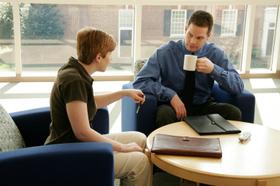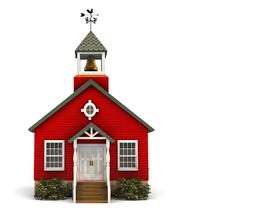Have you ever wondered how a private school got its start? When and why was it founded? Who founded it? As I researched this article, which is a companion article to several I have written for Boarding School Review about boarding schools, I found a common thread. The founders of all these schools sought to provide a balanced, comprehensive, excellent education for their students.
Allen-Stevenson School, New York, New York
- Founded in 1883
- 200 students
- Grades K-8
- Boys
- Non-denominational
- Urban setting
The Allen-Stevenson School in New York City was founded in 1883 by Francis Bellows Allen at a home on Fifth Avenue and 57th Street. It started with only three boys enrolled in its first class. In 1885, the school moved to rented rooms at Madison Avenue and 44th Street with an enrollment of 20 boys. In 1904, Allen met Robert Alston Stevenson, a tutor, and they joined forces, moving the school to 50 East 57th Street with 100 students.[5] By 1918, enrollment exceeded 200 students. In 1924, the school purchased two brownstones and moved to its present location at 132 East 78th Street on the Upper East Side. Allen retired in 1939 at age 80 after 56 years of service, while Stevenson retired in 1947 after 43 years, with his son Robert "Huck" Alston Stevenson Jr. succeeding him as Headmaster. Over the years, the school has expanded its facilities, introduced new academic and extracurricular programs, and celebrated significant milestones like its centennial in 1983. It remains an all-boys private school from kindergarten through 8th grade, focused on providing a well-rounded education in academics, athletics, and the arts.
This video offers a look at the Allen-Stevenson School in New York, New York.
- Founded in 1935
- 1200 students
- Grades NS-12
- Coeducational
- Non-denominational
- Urban setting
The Lycée Français de New York was founded in 1935 by Charles de Ferry de Fontnouvelle, the Consul General of France in New York. He envisioned creating a top bilingual French-American school to shape future leaders with a global outlook. The school started humbly with just 24 students in three grades in a small basement. Despite being founded during the Great Depression, it quickly grew, receiving its charter from the New York State Board of Regents in 1938 and granting its first French baccalaureate degree that year. Over the following decades, the school expanded and moved locations multiple times to accommodate its growing student body, reaching over 1,000 students by the 1970s. In 1994, it acquired a new building on East 73rd Street. In 2003, it consolidated its primary and secondary schools into its current block-long campus on East 75th Street, inaugurated by French President Jacques Chirac.
The Lycée has seen over 36,000 students from more than 150 nationalities pass through its doors since its founding. It has maintained close ties to the French government while operating as an autonomous American institution with an American-majority board. Eight of its alumni died fighting in World War II. Today, the Lycée continues its mission of providing a rigorous bilingual French-American education from nursery through high school, preparing students for the French baccalaureate while offering a well-rounded curriculum in academics, arts, and athletics. It has over 1,300 students representing 60 nationalities.
Here is a look at the Lycée in New York, New York.
Catherine Cook School, Chicago, Illinois
- Founded in 1975
- Around 450 students
- Grades NS-8
- Coeducational
- Non-denominational
- Urban setting
The Catherine Cook School in Chicago, Illinois, was founded in 1975 as the Melrose Cooperative Nursery School. It was initially housed in the Jewish Reconstructionist Congregation in Evanston before moving to its current location in Chicago's Edgewater neighborhood. The school started with a passionate group of teachers and parents with more determination than funds. In 1992, they renovated a building to house the growing school community. As enrollment increased, the school transitioned to a professional administrative structure with a Board of Trustees in 1997, reorganizing into its current form as an independent school. Since then, the Catherine Cook School has experienced rapid growth, expanding its facilities and programs to serve preschoolers through 8th grade. It aims to empower students to be adaptive, confident, and productive stewards of an evolving world.
The school is named after Catherine Cook, a Greek immigrant who overcame significant obstacles to become one of the first women in the United States to qualify as an attorney and a certified public accountant. She was elected president of various legal associations, including the Hellenic Bar Association and the West Suburban Bar Association. Cook embodied the school's core values through perseverance, hard work, and commitment to making a difference in her community. Today, the Catherine Cook School is a testament to the vision, dedication, and care of its creative teachers, parents, and trustees, providing a nurturing educational environment for its students.
This video reports on the school's new building.
Shattuck-St. Mary's, Faribault, Minnesota
- Founded in 1858
- 450 students
- Grades NS-8
- Coeducational
- Episcopal
Shattuck-St. Mary's is a prestigious, coeducational Episcopal-affiliated boarding and day school in Faribault, Minnesota. It was founded in 1858 as an Episcopal mission school and seminary by Reverend James Lloyd Breck. Within a decade of its founding, the school grew to include Shattuck Military Academy for boys, St. Mary's Hall for girls, and later in 1901, St. James School for younger boys. The newly established Episcopal Diocese of Minnesota selected Henry Benjamin Whipple as its first bishop in 1860, who took over the school's leadership and transformed it into "an honest school" focused on education. In 1865, the military program was introduced by Tommy Crump, an English divinity student who lasted for over a century with the campus known as Shattuck Military Academy. St. Mary's Hall for Girls was opened in 1866 by Whipple. The three schools - Shattuck, St. Mary's, and St. James - were merged into the present-day Shattuck-St. Mary's in 1972. The military program was discontinued in 1974, and the school transitioned to its current coeducational structure.
Today, Shattuck-St. Mary's is renowned for its Centers of Excellence programs in engineering, bioscience, pre-conservatory music, vocal performance, hockey, soccer, figure skating, and golf. It has a 250-acre campus and an enrollment of around 400 students from across the U.S. and worldwide, with approximately 80% being boarders. The school maintains its Episcopal heritage while fostering an inclusive community that respects diverse religious backgrounds.
This video offers an overview of Shattuck-St. Mary's in Faribault, Minnesota.
The University of Chicago Laboratory Schools
- Founded in 1896 in Chicago, Illinois
- 2,000 students
- Nursery through Grade 12
- Coeducational
- Non-denominational
- Urban setting
The University of Chicago Laboratory Schools, or Lab Schools or U-High, is a private, co-educational day school from nursery through 12th grade in Chicago, Illinois. It has a long and distinguished history as one of the most influential progressive education institutions in the United States. The Lab Schools were founded in 1896 by the renowned American philosopher and educator John Dewey in the Hyde Park neighborhood of Chicago. Dewey established the school as an experimental institution to test and implement his progressive educational theories and ideas. The school began as an elementary school under the aegis of the University of Chicago's Department of Pedagogy, serving as a "laboratory" for Dewey to put his educational philosophies into practice. It attempted to create a unified, progressive school system from kindergarten through university level.
Over the years, the Lab Schools evolved and expanded, eventually comprising a Nursery School, Kindergarten, Lower School, Middle School, and High School. The school's growth was aided by the support of influential figures like Anita McCormick Blaine, daughter of Cyrus McCormick, who provided a significant endowment. In 1901, the renowned educator Colonel Francis Wayland Parker joined the school, further strengthening its progressive education approach. Parker's "child-centered education" philosophy complemented Dewey's ideas, and together they attracted a talented staff of teachers.
The University of Chicago Laboratory Schools has profoundly influenced progressive education in the United States and beyond. It served as a model for other laboratory schools and experimental educational institutions. Over its 125+ year history, the Lab Schools have maintained their commitment to progressive education principles, such as engaging students as active participants in their learning, fostering critical thinking, and promoting diversity, equity, and social justice. Today, the Lab Schools continue to be affiliated with the University of Chicago, providing a unique educational experience that combines progressive pedagogy with access to the university's resources and faculty. It remains a highly regarded institution known for its academic excellence and innovative approach to education.
This video offers a look at The University of Chicago Laboratory Schools in Chicago, Illinois.
The Spence School, New York, New York
- Founded in 1892
- Around 750 students
- Grades K-12
- Girls only
- Non-denominational
- Urban setting
The Spence School is a prestigious independent all-girls school in New York City. Its rich history dates back to 1892 when Clara B. Spence founded it on West 48th Street. The school started with just a handful of students. Over the years, It grew in size and reputation, eventually moving to its current location on East 91st Street.
The Spence School provides a rigorous academic program from kindergarten through 12th grade, preparing young women for academic excellence and responsible citizenship. The curriculum emphasizes critical thinking, creativity, and a passion for learning across various disciplines, including English, history, mathematics, sciences, languages, arts, and more. The school's philosophy is rooted in progressive education principles, fostering an inclusive and diverse learning environment.
In 2011, the school purchased a site on East 90th Street for $26 million to construct a new athletic facility, Spence 412, featuring squash courts, a basketball court, and a dance studio. The construction of the new athletic facility sparked controversy due to its potential impact on the historic facade of the former St. Joseph's Orphan Asylum, which was revealed during demolition. Today, The Spence School continues to uphold its legacy as a leading educational institution for girls and young women in New York City, providing a well-rounded and enriching learning experience while maintaining its commitment to diversity, equity, and social responsibility.
This video offers an overview of The Spence School in New York, New York..
As you research schools you are considering for your child, read about their history, as that will significantly influence the school's purpose and character. You can find profiles of private day schools here on Private School Review. Use these profiles as a starting point in your exploration of schools.
Questions? Contact us on Facebook or Instagram. @privateschoolreview
#privateschools #schoolfounders























